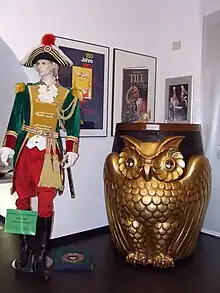
A Büttenrede lit. 'barrel speech' (also washtub speech, carnival speech) is a humorous speech, originating in the western German cultural tradition, that is given during carnival.[1] It is usually given at carnival conventions, revue-like events organized by carnival societies. Büttenreden are often rhymed and are performed from a special lectern called a bütt (rhenish franconian/moselle franconian/colognian/rhinelandic for barrel, vessel) in a local German dialect. Over the last few decades, Büttenreden have also become more popular in eastern Germany, including at the Berlin carnival.[2]
Format
Especially in the Rhenish carnival tradition, the format of the traditional Büttenrede has undergone many changes. The spectrum of Büttenreden nowadays ranges from elements of stand-up comedy and sung interludes to dialogues and ventriloquism. Even the bütt itself is only rarely visible, although this is usually for technical reasons. The content of the speeches has also gradually shifted from an expository, ironic mirroring of society to merely performing a collection of jokes.[3]
Origin
The Büttenrede can be traced back to the medieval practice of Rügerecht, through which peasants were allowed to freely criticize their rulers during carnival without fear of retribution.[4]
Rhyme structure
Structurally, the traditional rhymed Büttenrede is known to use a very consistent metre, for example iambic pentameter. It is often divided into multiple stanzas, that, like a refrain, end in the same, reoccurring punch line. The preferred rhyme scheme is a couplet (AA BB).[2]
Televised carnival conventions
There are several long-running broadcasts of Büttenreden through carnival conventions designed for TV on German public television. Prominent examples include Mainz bleibt Mainz, wie es singt und lacht, Fastnacht in Franken, and Kölle Alaaf.[5]
Controversy
The use of racist and misogynistic language has a well-documented history in this tradition, and, in more recent times, has sparked discussions around bigotry in the carnival scene as a whole.[6][7] In 2020, an orator in the village of Süplingen in Saxony-Anhalt held a Büttenrede in which he used derogatory language towards asylum seekers and Black people. Although the head of the local carnival society originally refused to censure him, the speaker ultimately apologized and resigned from the society.[8]
References
- ↑ Brophy, James M. (2017), ""The Modernity of Tradition": Popular Culture and Protest in Nineteenth-Century Germany", Protest, Popular Culture and Tradition in Modern and Contemporary Western Europe, London: Palgrave Macmillan UK, pp. 21–43, doi:10.1057/978-1-137-50737-2_2, ISBN 978-1-137-50736-5, retrieved 2023-01-09
- 1 2 Rheinland-Pfalz, Landesbibliothekszentrum. "Durch welche (sprachlichen) Merkmale zeichnet sich eine Büttenrede aus?". Landesbibliothekszentrum Rheinland-Pfalz (in German). Retrieved 2023-01-09.
- ↑ ""Showtänze sind jetzt angesagt"". www.fr.de (in German). Retrieved 2023-01-09.
- ↑ Zeitung, Aachener (2009-01-19). "Düren: Ursprung der Büttenrede geht ins Mittelaler zurück". Aachener Zeitung (in German). Retrieved 2023-01-09.
- ↑ "Fernsehlexikon » Mainz wie es singt und lacht". Retrieved 2023-01-09.
- ↑ Simon, Violetta. ""Sexismus ist fest in den Karneval eingewoben"". Süddeutsche.de (in German). Retrieved 2023-01-08.
- ↑ Deutschland, RedaktionsNetzwerk. "Sexismus, Rassismus, Diskriminierung: Was ist im Karneval erlaubt?". www.rnd.de (in German). Retrieved 2023-01-08.
- ↑ Zeitung, Westdeutsche (2020-01-20). "Süplingen: Rassistische Büttenrede wird auf Karnevalssitzung beklatscht". Westdeutsche Zeitung (in German). Retrieved 2023-01-08.